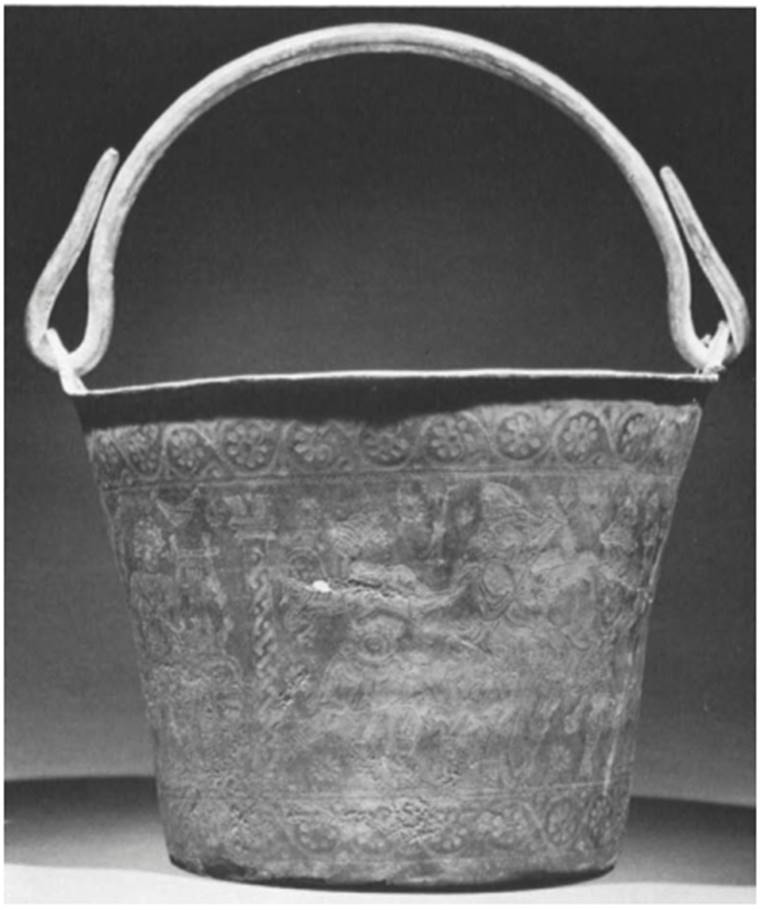The Doria bucket. Egypt (?), 5th century. Bronze
The bucket, or situla, is relatively well preserved but would not hold water; the surface is in places corroded. The designs on the sides were achieved in a variety of techniques: most contour lines were traced; the stippling of flesh and the small circles on shoes, hair, and drapery were produced with a variety of punches.
The figurative scenes, which are separated by spiral columns, illustrate two episodes concerning Achilles and his concubine Briseis (Нот. II. 1. 318-348, 24. 643-676). The first is spread across three intercolumniations: Achilles is seated at the left, playing the lyre; next to him stands a figure who may be Patroclus. Achilles looks toward Briseis, who is being led away by the two heralds Talthybius and Eurybates. In the next bay is Agamemnon, who had ordered Achilles to give up Briseis and who gestures here as though to welcome the returning heralds. Like Priam in the following scene, Agamemnon is shown with the type of nimbus appropriate for kings. The second scene illustrates a later moment; Briseis has now returned to Achilles, and he to the fighting. Hector is dead, and his father, Priam, has come to ransom his body (cf. no. 210). The old man is asleep in the entrance to Achilles' tent, with his herald below him; at the left stands Achilles, once again playing the lyre. Briseis, led by a servant, tiptoes toward him as if trying not to awaken Priam.

The arrangement of the group of Briseis and the heralds is similar to the analogous scenes in the Munich papyrus (no. 194) and the bronze plaque (no. 195), and it is clear that they belong to the same iconographic tradition. Briseis even wears the Phrygian cap as in no. 194. However, the second herald here, whose movement and gesture seem unmotivated, was substituted by the artist for the original pushing herald; a figure similar to this herald appears on the bronze plaque (no. 195) addressing Achilles. From such substitutions we can see that the artist tended to reuse established figure types rather than invent new ones.
These changes do not always enhance the sense of the narrative; the psychological understanding of the bronze plaque is also missing here. Although the scenes on the bucket are ultimately based on the Iliad, they also contain elements more directly derived from a lost Achilleis, the illustrations for which are found in the works grouped around a silver plate (no. 208). The non-Iliadic elements on the bucket are the group of Achilles and Patroclus, the seated Agamemnon (who is not mentioned as receiving Briseis by Homer), and the scene with Priam. Homer says merely that Priam slept in the porch of Achilles' tent and that Achilles slept that night with Briseis. The Achilleis poet embroidered the situation, emphasizing romantic qualities; this is shown by the little Eros who flies toward the lovers.
There are no parallels for this scene. The quality of the incision is reminiscent of that on the bronze plaques (nos. 195, 215) in the fullness of the limbs and in the vivacity of drapery and movement. Yet because of the short strokes of the tracing tool, the line is nervous and less harmonious. Space is treated more two-dimension- ally; rosettes in the interstices between figures emphasize the decorative quality of the surface. The roughness of the style and the tendencies toward abstraction suggest that the situla is Egyptian (cf. no. 198); parallels in metalwork, textiles, and ivory indicate a date in the fifth century.
A tradition holds that the piece may come from Caesarea in Palestine; it has long been in the Doria collection in Rome. Bibliography: Weitzmann, 1959, pp. 249-251; Carandini, 1963-1964.
Date added: 2025-08-31; views: 86;
